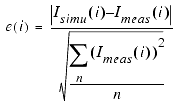Print version of this Book (PDF file)
Relative/Absolute Error Formulation
With the exception of the Minimax, Gradient Minimax, and Random Minimax optimizers, all other algorithms use two error formulations: relative error and absolute error. (Minimax, Gradient Minimax, and Random Minimax optimizers use only absolute error.)
These error formulations can be expressed using the following equations:
- Relative error:
- Absolute Error:
- where
- Isimu and Imeas represent the simulated and target data sets specified in the Inputs page of the optimizer, and
- n the number of data points included in each data set.
- Absolute Error:
Special handling is done for the Relative Error case to avoid situations where Imeas(i) is zero or much smaller than the numerator. For the Levenberg-Marquardt optimizer, the formulation is
For the other optimizers, Imeas(i) is used for the denominator for all points except when Imeas(i)==0 and only then is Isimu(i) used in the denominator.
To select the desired error formulation, choose Absolute or Relative from the Error drop-down box on the Extract/Optimize page.
The absolute error is normalized using the RMS of the measured or target data set, which remains a constant quantity during optimization. This normalization assists the optimizer when different inputs are defined, otherwise inputs with a higher order of magnitude would prevail.


